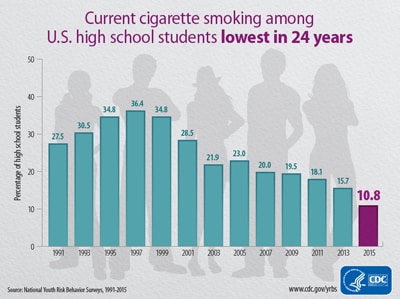Cigarette smoking among high school students dropped to the lowest levels since the National Youth Risk Behavior Survey (YRBS) began in 1991, but the use of electronic vapor products, including e-cigarettes, among students poses new challenges according to the 2015 survey results released today by the Centers for Disease Control and Prevention.
Although current cigarette use decreased significantly from 28 percent in 1991 to 11 percent in 2015, new data from the 2015 survey found that 24 percent of high school students reported using e-cigarettes during the past 30 days.
In May 2016, the U.S. Food and Drug Administration finalized an important rule extending its authority to all tobacco products, including e-cigarettes. The rule includes, for the first time, a restriction on the sale of these products to minors nationwide.
A wealth of data on teen health-related behaviors
The YRBS provides important data related to student behaviors, such as behaviors that contribute to unintentional injuries and violence.
The 2015 survey findings indicated that youth continue to be at risk by using wireless devices while driving:
- Among high school students who had driven a car or other vehicle during the past 30 days, the percentage of high school students who texted or e-mailed while driving ranged from 26 percent to 63 percent across 35 states and from 14 percent to 39 percent across 18 large urban school districts.
- Nationwide, 42 percent of students who had driven a car or other vehicle during the past 30 days reported texting or e-mailing while driving. This percentage did not change from 2013.
- The percentage of high school students nationwide who had been in a physical fight at least once during the past 12 months decreased from 42 percent in 1991 to 23 percent in 2015.
- Six percent of students missed at least 1 day of school during the past 30 days because they felt they would be unsafe at school or on their way to or from school. The percentage of students not going to school because of safety concerns decreased from 2013 (7 percent) to 2015 (6 percent).
- Prescription drug use among youth decreased from 20 percent in 2009 to 17 percent in 2015. Nationwide, 17 percent of students had taken prescription drugs (e.g., Oxycontin, Percocet, Vicodin, codeine, Adderall, Ritalin, or Xanax) without a doctor’s prescription one or more times during their life.
- The percentage of high school students who are currently sexually active (had sexual intercourse during the past three months) has been decreasing since 1991, dropping from 38 percent in 1991 to 30 percent in 2015. Current sexual activity also decreased from 34 percent in 2013 to 30 percent in 2015.
- Among high school students who are currently sexually active, condom use decreased from 63 percent in 2003 to 57 percent in 2015, following more than a decade of increases that peaked in the early 2000s. Condom use did not change from 2013 (59 percent) to 2015 (57 percent).
- The proportion of currently sexually active students who had drunk alcohol or used drugs before last sexual intercourse decreased from 25 percent in 1999 to 21 percent in 2015, but did not change from 2013 (22 percent) to 2015 (21 percent).
- Nationwide, 10 percent of all students had ever been tested for HIV. This is a decrease from 13 percent in 2011 and 2013.
- There was a significant decrease in drinking soda one or more times a day from 27 percent in 2013 to 20 percent in 2015.
- From 2003-2015, the percentage of high school students playing video or computer games or using a computer three or more hours per day (for non-school related work) nearly doubled from 22 percent to 42 percent.

No comments:
Post a Comment